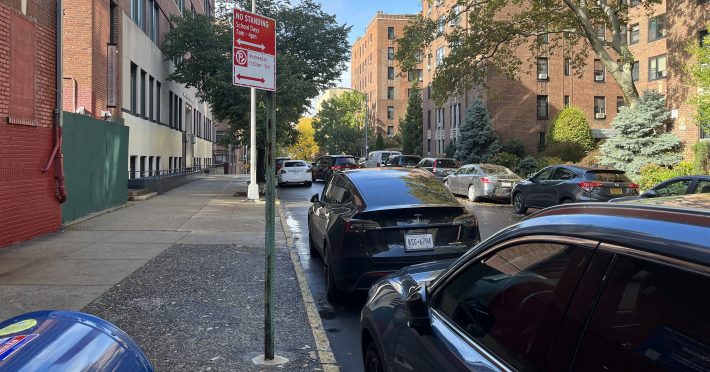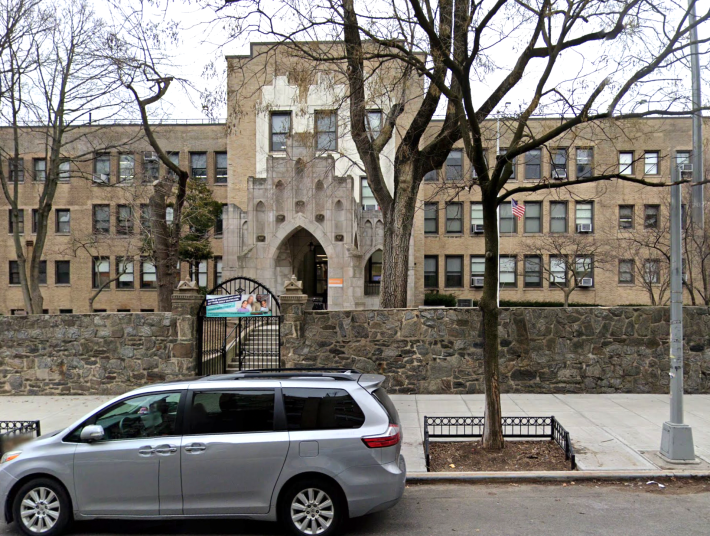Neighborhoods in Upper Manhattan are being jammed with honking, double-parked car drivers morning and afternoon during the week as local charter schools open or expand without planning for the increased traffic — and the city does little to help, residents say.
The twice-daily mayhem at drop-off and pickup has Washington Heights and Inwood residents fuming — and they fault the departments of Transportation, Education, and Buildings, which do not require that charter schools plan for traffic management. The cops of the 34th Precinct (some of the worst parking offenders in the city, as Streetsblog has documented) also don't help much, they say.
The issue is coming to a head because two new charters are planning to open in the neighborhood — an as-yet-unnamed school at the Fort Washington Collegiate Church on West 181st Street, and Zeta Inwood, which will move its K-6 students from two temporary locations into a permanent 120,000-square-foot facility at 400 W. 219th St. next year. Zeta will add two more grades there and says it will open a high school in the neighborhood in 2026.
Those schools join a slew of earlier campuses — including the 600-student Success Academy campus at the former Mother Cabrini High School at 701 Fort Washington Ave., the 300-student (and-growing) Amber Charter School at 532 W 215th St., and two local KIPP Schools — that have congested the tight, hilly streets of midlevel 1930s and '40s apartment houses.
The school traffic — generated by parents in cars dropping off and picking up their kids, many of whom live outside the area — has prompted much discussion at Manhattan Community Board 12, where residents recently voiced concerns that parents' rampant double parking twice a day in front of the Amber Charter School creates dangers not only for street users, but make it impossible for ambulances or other emergency vehicles to pass.
At a meeting last month, board member Osi Kaminer described the daily mess at the Amber school around pickup and drop off along Park Terrace East. "Nothing is moving ... from 218th Street down to 215th ... The traffic just stands for 20 minutes," Kaminer said.

And not only Amber Terrace.
Donna Filippone, who lives on 190th Street, has what she called a "bird's eye" view of the "traffic nightmare" at the Success Academy at the former Cabrini campus. The school used to house a neighborhood Catholic school whose students mainly walked to class, but now it has become a "giant cluster you-know-what" three times a day, as parents "double park in the middle of the street," "roll through stop signs, almost hitting people," and "park at bus stops" in order to get their children to school, she said.
"At 7:20 a.m., you can set your alarms, the honking starts," Filippone said, adding that the situation probably will worsen when new schools open on surrounding blocks. Despite years of meeting with various officials, "no one really care or pays attention," she said, adding, "when will the DOT come up here and see what this mess is doing to our quality of life?"
The charter schools say that they are working with city agencies, including the DOT and NYPD, on traffic-management measures. But such messes happen in the first place because of lack of planning around charter sitings. Basically, traffic mitigation doesn't happen because it's no single agency's job.
"Vision Zero street-safety training is offered" to every district school but "charter schools are not within the purview of the Department of Education," DOE deputy press secretary Jenna Lyle told Streetsblog.
The DOT also throws up its hands; according to the agency that oversees our streets, if a school is lawfully located in a zone, the DOT cannot prevent it from operating. The Buildings Department confirmed that it does not require traffic-mitigation plans in order for charter schools to receive a Certificate of Occupancy.
Nor do the chartering agencies want anything to do with siting. The SUNY Charter Schools Institute, the body that authorized the Amber School, for one, told the Inwood Owners Coalition that "noise and traffic complaints ... are outside of SUNY’s jurisdiction" because SUNY "does not approve certificates of occupancy or enforce traffic or parking" in the city, according to letters obtained by Streetsblog.
The charter-school traffic problems in Upper Manhattan are only one example of the chaos and dangers city students face on the streets around schools of all kinds. In May, a six-month Streetsblog investigation found that on school days, streets near schools have rates of crashes and injuries that exceed city averages — especially those near schools with mostly poor or minority students. Drop-off and pickup are the worse times, of course. For example, during the 8 a.m. arrival hour, there are 57 percent more crashes and 25 percent more injuries per mile on streets near schools — a disparity that vanishes on non-school days. Streetsblog's reporting prompted vows from Mayor Adams to do better, but the DOE has resisted addressing the issue.

Some 142,500 students attend the 275 charters in the city, including 56 in Manhattan, according to the New York City Charter School Center, but the organization does not track how students arrive at school, a rep said. The students are entitled to the same bus service as those traveling to district schools, but the fact that the charters tend to draw students from a much wider area than district schools makes it more likely children will arrive by car.
Empirical research bears that out. A recent Brookings study of the length of school bus rides in the city found that "students who attend a zoned school have an average bus ride of about 13 minutes, while students who attend charter schools or district-run schools other than their own zoned school have commutes that are around 25 minutes ... because students who attend district choice or charter schools tend to live farther away from their school."
Meanwhile, parents who drive their kids to school are doing no one a favor, least of all their own kids. In a change from a generation ago — when busing, walking and biking were more common — most children in the U.S. (54.2 percent) get to school in a private vehicle versus a school bus (33.2 percent) or active transportation (10.4 percent), according to the latest National Household Travel Survey. The change has contributed to an explosion of childhood obesity that has made American children some of the world's fattest. It is also partially responsible for an epidemic of road violence against pedestrians and cyclists.
The Amber school is located in a former convent on West 215th, a hilly, one-way, residential street wedged between Park Terrace East and West. The street has one travel lane, a parking lane on the north side, and a "No Standing" loading zone in front of the school marked for school days 7 a.m. to 4 p.m.
At dismissal on Oct. 25, parents in cars ignored that sign, as well as all others. At 2:30 p.m., an SUV driver parked in front of the fire hydrant across from the school. Meanwhile, other drivers started circling the block or parked illegally at corners. A Tundra pickup-truck driver soon positioned his vehicle in the middle of Park Terrace East, idling.
By 2:45 parents had filled the "no standing zone" and were double parked in front of the school. By 2:55 they were triple-parked. By 3 p.m. motorists — horns blaring — had lined up not only on 215th Street but around the block on Park Terrace East from 215th up to 218th. Two mini school buses struggled into the mix.
The DOT says that it is studying whether it can install all-way stop signs on Park Terrace East and West to facilitate walkers. The agency "is laser-focused on improving safety and traffic flow outside of schools with street redesigns, expanded automated enforcement, and robust educational outreach," according to spokeswoman Mona Bruno. "We also have a large toolbox of congestion mitigation strategies and we’re continuing to evaluate ways we can enhance safety at schools not only in Inwood and Washington Heights, but citywide.”
There have been 3,671 crashes just in Inwood alone in the last five years — more than an average of two per day in a small neighborhood — killing four people and injuring 1,192, including 105 cyclists, 232 pedestrians and 855 motorist.
Neighbors have met with the school for more than two years in an effort to get it to stage traffic in a wider area, according to comments on a local Facebook group, and are set to meet with school reps soon. A spokeswoman for Amber was traveling last week.
"The real elephant in the room is that the school is only 300 students right now but will eventually triple in size to 929 students," one commenter observed.
A Success Academy rep, Ann Powell, said that the Washington Heights school has partnered with the local precinct and elected officials to address traffic concerns, including "frequent meetings, NYPD patrols and observations, and regular check-ins... going back to at least 2017." This year, the school requested traffic police or crossing guards at arrival/dismissal, but because of a shortage of traffic agents, "they have told us they won't come daily."
The school compensates by sending staff members to direct traffic and scold double-parking parents; it has tried to spread out dismissal times, with fewer grades let out on Ft. Washington Avenue, where traffic is heavier, and more grades on less-traveled Cabrini Boulevard.
Powell acknowledged that parents' compliance "is inconsistent" and that illegal parking remains a problem. Even so, "We believe the steps we have taken have improved the traffic flow this year, and we’ll continue to do our part to be good neighbors," she said.
Some parents are looking for a way out of the driving-to-school mess.
"What can we do to reduce the number of car drop-offs and pick-ups at neighborhood schools? Why do families today feel so much less comfortable letting their children walk or bike to school? And what can we do to make them feel more comfortable?," parent Daniel McNickle opined in the Riverdale Press about the traffic problems around a district school, P.S. 81 in The Bronx. "I believe this line of inquiry can lead to a reduction in traffic and a stronger community. Walking to school was good enough for my parents. Why not my children?"
A request for comment sent to Zeta drew an automated response.






